Sulphide Globules in a Porcellanite–Buchite Composite Xenolith from Stromboli Volcano (Aeolian Islands, Southern Italy): Products of Open-System Igneous Pyrometamorphism
Abstract
1. Introduction
- Buchite. A partly to almost completely vitrified rock resulting from intense contact metamorphism. The term was coined by Mohl [9]—probably after the German geologist Leopold Von Buch [10]—to describe fused rocks in contact with basalt, replacing the term basalt jasper. Although then applied to partially melted sandstones [11], buchite was later used to describe fused pelitic rocks [12].
- Porcellanite. A light colored, very fine grained, completely recrystallized pyrometamorphosed clay, marl, or shale—originally named from a naturally baked clay considered to be a variety of jasper [13] which led to the adoption of the now obsolete term porcelain–jasper.
2. Geology and Magmatism of Stromboli Volcano
2.1. Stromboli Degassing and Hydrothermal System
2.2. Stromboli Hydrothermal-Rock Ejecta
3. Materials and Methods
4. Results
4.1. Mineral Phases and Glass Compositions
4.2. Major and Trace Elements Bulk Rock Composition
5. Discussion
Space-Time Inferences on the Formation of the Porcellanite-Buchite Xenolith
6. Conclusions
Supplementary Materials
Author Contributions
Funding
Data Availability Statement
Acknowledgments
Conflicts of Interest
References
- Grapes, R. Pyrometamorphism; Springer: Berlin, Germany, 2011; 365p. [Google Scholar]
- Brauns, R. Die chemische Zusammensetzung granatführender kristalliner Scheifer, Cordieritgesteine und Sanidinite aus dem Laacher Seegebeit. N. J. Mineral. Geol. Pal. 1912, 34, 85–175. [Google Scholar]
- Barton, M.D.; Staude, J.M.; Snow, E.A.; Johnson, D.A. Aureole systematics. In Contact Metamorphism; Kerrick, D.M., Ed.; Reviews in Mineralogy, Mineralogical Society of America: Chelsea, MI, USA, 1991; Volume 26, pp. 723–847. [Google Scholar]
- Yoder, H.S.; Tilley, C.E. Origin of basaltic magmas: An experimental study of natural and synthetic rock systems. J. Petrol. 1962, 3, 342–532. [Google Scholar] [CrossRef]
- Tuttle, O.F.; Bowen, N.L. Origin of granite in the light of experimental studies in the system NaAlSi2O8–KAlSi2O8–SiO2–H2O. Geol. Soc. Am. Mem. 1958, 74, 153. [Google Scholar]
- Holdaway, M.J. Stability of andalusite and the aluminium silicate phase diagram. Am. J. Sci. 1971, 271, 97–131. [Google Scholar] [CrossRef]
- Kennedy, G.C.; Wasserburg, F.J.; Heard, H.C.; Newton, R.C. The upper three–phase region in the system SiO2–H2O. Am. J. Sci. 1962, 260, 501–521. [Google Scholar] [CrossRef]
- Ostrovsky, I.A. PT–diagram of the system SiO2–H2O. Geol. J. 1966, 5, 127–134. [Google Scholar] [CrossRef]
- Mohl, H. Die südwestlichsten Ausläufer des Vogelsgebirges. Offenb. Ver. Nat. 1873, 14, 51–101. [Google Scholar]
- Tomkeieff, S.I. The dolerite plugs of Tieveragh and Tievebulliagh near Cushendall, Co.Antrim, with a note on buchite. Geol. Mag. 1940, 7, 54–64. [Google Scholar] [CrossRef]
- Harker, A. The Tertiary Igneous Rocks of Skye; H.M. Stationery Office: Glasgow, Scotland, 1904. [Google Scholar]
- Thomas, H.H. On certain xenolithic Tertiary minor intrusions in the Island of Mull (Argyllshire). Q. J. Geol. Soc. Lond. 1922, 78, 229–259. [Google Scholar] [CrossRef]
- Werner, A.G.; Bergm, J. Traité Elémentaire de Mineralogie I; Brochant, A.J.M., Ed.; Villier: Paris, France, 1789; 644p. [Google Scholar]
- Killie, I.C.; Thompson, R.N.; Morrison, M.A.; Thompson, R.F. Field evidence for turbulence during flow of basalt magma through conduits from southwest Mull. Geol. Mag. 1986, 123, 693–697. [Google Scholar] [CrossRef]
- Holness, M.B.; Watt, G.R. The aureole of the Traigh Bhàn na Sgùrra Sill, Isle of Mull: Reaction driven microcracking during pyrometamorphism. J. Petrol. 2001, 43, 511–534. [Google Scholar] [CrossRef]
- Koritnig, S. Die Blaue Kuppe bei Eschwege mit ihren Kontakterscheinungen. Contrib. Miner. Pet. 1955, 4, 504–521. [Google Scholar] [CrossRef]
- Salvioli-Mariani, E.; Renzulli, A.; Serri, G.; Holm, P.M.; Toscani, L. Glass–bearing crustal xenoliths (buchites) erupted during the recent activity of Stromboli (Aeolian Islands). Lithos 2005, 81, 255–277. [Google Scholar] [CrossRef]
- Balassone, G.; Franco, E.; Mattia, C.A.; Puliti, R. Indialite in xenoliths from Somma–Vesuvius volcano (Southern Italy): Crystal chemistry and petrogenetic features. Am. Mineral. 2004, 89, 1–6. [Google Scholar] [CrossRef]
- Wood, C.P. Mineralogy at the magma–hydrothermal system interface in andesite volcanoes. Geology 1994, 22, 75–78. [Google Scholar] [CrossRef]
- Wood, C.P.; Browne, P.R.L. Chlorine–rich pyrometamorphic magma at White Island volcano, New Zealand. J. Volcanol. Geoth. Res. 1996, 72, 21–35. [Google Scholar] [CrossRef]
- Del Moro, S.; Renzulli, A.; Tribaudino, M. Pyrometamorphic processes at the magma–hydrothermal system interface of active volcanoes: Evidence from buchite ejecta of Stromboli (Aeolian Islands, Italy). J. Petrol. 2011, 52, 541–564. [Google Scholar] [CrossRef]
- Del Moro, S.; Renzulli, A.; Landi, P.; La Felice, S.; Rosi, M. Unusual lapilli tuff ejecta erupted at Stromboli during the 15 March 2007 explosion shed light on the nature and thermal state of rocks forming the crater system of the volcano. J. Volcanol. Geoth. Res. 2013, 254, 37–52. [Google Scholar] [CrossRef]
- Fegley, B.; Prinn, R.G. Estimation of the rate of volcanism on Venus from reaction rate measurements. Nature 1989, 337, 55–58. [Google Scholar] [CrossRef]
- Ayris, P.M.; Lee, A.F.; Wilson, K.; Kueppers, U.; Dingwell, D.B.; Delmelle, P. SO2 sequestration in large volcanic eruptions: High temperature scavenging by tephra. Geochim. Cosmochim. Acta 2013, 110, 58–69. [Google Scholar] [CrossRef]
- Henley, R.W.; King, P.L.; Wykes, J.L.; Renggli, C.J.; Brink, F.J.; Clark, D.A.; Troitzsch, U. Porphyry copper deposit formation by sub–volcanic sulfur dioxide flux and gas–solid. Nat. Geosci. 2015, 8, 210–215. [Google Scholar] [CrossRef]
- Henley, R.W.; Seward, T.M. Gas–Solid Reactions in Arc Volcanoes. Ancient and Modern. Rev. Mineral. Geochem. 2018, 84, 309–349. [Google Scholar] [CrossRef]
- Henley, R.W.; Fischer, T.P. Sulfur sequestration and redox equilibria in volcanic gases. J. Volcanol. Geoth. Res. 2021, 412, 107181. [Google Scholar] [CrossRef]
- Métrich, N.; Bonnin–Mosbah, M.; Susini, J.; Menez, B.; Galoisy, L. Presence of sulfite (SIV) in arc magmas: Implications for volcanic sulfur emissions. Geophys. Res. Lett. 2002, 29, 1–4. [Google Scholar] [CrossRef]
- Di Carlo, I.; Pichavant, M.; Rotolo, S.G.; Scaillet, B. Experimental crystallization of a high–K arc basalt: The golden pumice, Stromboli volcano (Italy). J. Petrol. 2006, 47, 1317–1343. [Google Scholar] [CrossRef]
- Pichavant, M.; Di Carlo, I.; Le Gac, Y.; Rotolo, S.G.; Scaillet, B. Experimental constraints on the deep magma feeding system at Stromboli volcano, Italy. J. Petrol. 2009, 50, 601–624. [Google Scholar] [CrossRef]
- Métrich, N.; Bertagnini, A.; Di Muro, A. Conditions of magma storage, degassing and ascent at Stromboli: New insights into the volcano plumbing system with inferences on the eruptive dynamics. J. Petrol. 2010, 51, 603–626. [Google Scholar] [CrossRef]
- Francalanci, L.; Manetti, P.; Peccerillo, A. Volcanological and magmatological evolution of Stromboli volcano (Aeolian Islands): The roles of fractional crystallization, magma mixing, crustal contamination and source heterogeneity. Bull. Volcanol. 1989, 51, 355–378. [Google Scholar] [CrossRef]
- Hornig–Kjarsgaard, I.; Keller, J.; Kobersky, U.; Stadlbauer, E.; Francalanci, L.; Lenhart, R. Geology, stratigraphy and volcanological evolution of the island of Stromboli, Aeolian Arc, Italy. Acta Vulcanol. 1993, 3, 21–68. [Google Scholar]
- Tibaldi, A. Multiple sector collapses at Stromboli volcano: How they work. Bull. Volcanol. 2001, 63, 112–125. [Google Scholar] [CrossRef]
- Francalanci, L.; Lucchi, F.; Keller, J.; De Astis, G.; Tranne, C.A. Chapter 13, Eruptive, volcano–tectonic and magmatic history of the Stromboli volcano (north–eastern Aeolian archipelago). In In The Aeolian Islands Volcanoes; Lucchi, F., Peccerillo, A., Keller, J., Tranne, C.A., Rossi, P.L., Eds.; Geological Society of London: London, UK, 2013; Volume 37, pp. 397–471. [Google Scholar]
- Rosi, M.; Bertagnini, A.; Landi, P. Onset of the persistent activity at Stromboli volcano (Italy). Bull. Volcanol. 2000, 62, 294–300. [Google Scholar] [CrossRef]
- Bertagnini, A.; Métrich, N.; Francalanci, L.; Landi, P.; Tommasini, S.; Conticelli, S. Volcanology and Magma Geochemistry of the Present–Day Activity: Constraints on the Feeding System. In The Stromboli Volcano: An Integrated Study of the 2002–2003 Eruption, Volume 182; Calvari, S., Inguaggiato, S., Puglisi, G., Ripepe, M., Rosi, M., Eds.; American Geophysical Union: Washington, DC, USA, 2008; pp. 19–37. [Google Scholar]
- Métrich, N.; Bertagnini, A.; Landi, P.; Rosi, M. Crystallization driven by decompression and water loss at Stromboli volcano (Aeolian Islands, Italy). J. Petrol. 2001, 42, 1471–1490. [Google Scholar] [CrossRef]
- Bertagnini, A.; Métrich, N.; Landi, P.; Rosi, M. Stromboli volcano (Aeolian Archipelago, Italy): An open window on the deep–feeding system of a steady state basaltic volcano. J. Geophys. Res. 2003, 108, 1–15. [Google Scholar] [CrossRef]
- Rosi, M.; Pistolesi, M.; Bertagnini, A.; Landi, P.; Pompilio, M.; Di Roberto, A. Chapter 14, Stromboli volcano, Aeolian Islands (Italy): Present eruptive activity and hazards. In The Aeolian Islands Volcanoes; Lucchi, F., Peccerillo, A., Keller, J., Tranne, C.A., Rossi, P.L., Eds.; Geological Society of London: London, UK, 2013; Volume 37, pp. 473–490. [Google Scholar]
- Giordano, G.; De Astis, G. The summer 2019 basaltic Vulcanian eruptions (paroxysms) of Stromboli. Bull. Volcanol. 2021, 83, 1. [Google Scholar] [CrossRef]
- Vezzoli, L.; Renzulli, A.; Menna, M. Growth after collapse: The volcanic and magmatic history of the Neostromboli lava cone (island of Stromboli, Italy). Bull. Volcanol. 2014, 76, 821. [Google Scholar] [CrossRef]
- Risica, G.; Speranza, F.; Giordano, G.; De Astis, G.; Lucchi, F. Palaeomagnetic dating of the Neostromboli succession. J. Volcanol. Geoth. Res. 2019, 371, 229–244. [Google Scholar] [CrossRef]
- Revil, A.; Finizola, A.; Ricci, T.; Delcher, E.; Peltier, A.; Barde–Cabusson, S.; Avard, G.; Bailly, T.; Bennati, L.; Byrdina, S.; et al. Hydrogeology of Stromboli volcano, Aeolian Islands (Italy) from the interpretation of resistivity tomograms, self–potential, soil temperature and soil CO2 concentration measurements. Geophys. J. Int. 2011, 186, 1078–1094. [Google Scholar] [CrossRef]
- Martinez–Arevalo, C.; Musumeci, C.; Patanè, D. Evidence of a partial melt zone beneath Stromboli volcano (Italy) from inversion of teleseismic receiver functions. Terra Nova 2009, 21, 386–392. [Google Scholar] [CrossRef]
- Ubide, T.; Caulfield, J.; Brandt, C.; Bussweiler, Y.; Mollo, S.; Di Stefano, F.; Nazzari, M.; Scarlato, P. Deep Magma Storage Revealed by Multi–Method Elemental Mapping of Clinopyroxene Megacrysts at Stromboli Volcano. Front. Earth Sci. 2019, 7, 239. [Google Scholar] [CrossRef]
- Métrich, N.; Bertagnini, A.; Pistolesi, M. Paroxysms at Stromboli Volcano (Italy): Source, Genesis and Dynamics. Front. Earth Sci. 2021, 9, 593339. [Google Scholar] [CrossRef]
- Salvioli-Mariani, E.; Mattioli, M.; Renzulli, A.; Serri, G. Silicate melt inclusions in the cumulate minerals of gabbroic nodules from Stromboli volcano (Aeolian Islands, Italy): Main components of the fluid phase and crystallization temperatures. Mineral Mag. 2002, 66, 969–984. [Google Scholar] [CrossRef]
- Mattioli, M.; Serri, G.; Salvioli-Mariani, E.; Renzulli, A.; Holm, P.M.; Santi, P.; Venturelli, G. Subvolcanic infiltration and syneruptive quenching of liquids in cumulate wall–rocks: The example of the gabbroic nodules of Stromboli (Aeolian Islands, Italy). Mineral. Petrol. 2003, 78, 201–230. [Google Scholar] [CrossRef]
- Spiess, R.; Dibona, R.; Faccenda, M.; Mattioli, M.; Renzulli, A. Mylonitic gabbro nodules of Stromboli (southern Italy): Microstructural evidence of high–temperature deformation of cumulates during the evolution of the magmatic crustal roots of an active volcano. Geol. S. Am. S. 2017, 526, 89–105. [Google Scholar]
- Renzulli, A.; Santi, P. Subvolcanic crystallization at Stromboli (Aeolian Islands, southern Italy) preceding the Sciara del Fuoco sector collapse: Evidence from monzonite lithic suite. Bull. Volcanol. 1997, 59, 10–20. [Google Scholar] [CrossRef]
- Menna, M.; Tribaudino, M.; Renzulli, A. Al–Si order and spinodal decomposition texture of a sanidine from igneous clasts of Stromboli (Aeolian arc, southern Italy): Insights into the timing between the emplacement of a shallow basic sheet intrusion and the eruption of related ejecta. Eur. J. Mineral. 2008, 20, 183–190. [Google Scholar] [CrossRef]
- Renzulli, A.; Del Moro, S.; Menna, M.; Landi, P.; Piermattei, M. Transient processes in Stromboli’s shallow basaltic system inferred from dolerite and magmatic breccia blocks erupted during the 5 April 2003 paroxysm. Bull. Volcanol. 2009, 71, 795–813. [Google Scholar] [CrossRef]
- Honnorez, J.; Keller, J. Xenolithe in vulkanischen Gesteinen Aolischen Inseln (Sizilien). Geol. Rundsch. 1968, 7, 719–736. [Google Scholar] [CrossRef]
- Renzulli, A.; Serri, G.; Santi, P.; Mattioli, M.; Holm, P.M. Original of high–silica liquids of Stromboli volcano (Aeolian Island, Italy) inferred from crustal xenoliths. Bull. Volcanol. 2001, 62, 400–419. [Google Scholar] [CrossRef]
- Renzulli, A.; Tribaudino, M.; Salvioli-Mariani, E.; Serri, G.; Holm, P.M. Cordierite anorthoclase hornfels xenoliths in Stromboli lavas (Aeolian Islands, Sicily): An example of a fast cooled contact aureole. Eur. J. Mineral. 2003, 15, 665–679. [Google Scholar] [CrossRef]
- Vaggelli, G.; Francalanci, L.; Ruggieri, G.; Testi, S. Persistent polybaric rests of calc–alkaline magmas at Stromboli volcano, Italy: Pressure data from fluid inclusions in restitic quartzite nodules. Bull. Volcanol. 2003, 65, 385–404. [Google Scholar] [CrossRef]
- Harlov, D.; Renzulli, A.; Ridolfi, F. Iron–bearing chlor–fluorapatites in crustal xenoliths from the Stromboli volcano (Aeolian Islands, Southern Italy): An indicator of fluid processes during contact metamorphism. Eur. J. Mineral. 2006, 18, 233–241. [Google Scholar] [CrossRef]
- Burton, M.R.; Caltabiano, T.; Murè, F.; Salerno, G.; Randazzo, D. SO2 flux from Stromboli during the 2007 eruption: Results from the FLAME network and traverse measurements. J. Volcanol. Geoth. Res. 2009, 182, 214–220. [Google Scholar] [CrossRef]
- Aiuppa, A.; Burton, M.; Caltabiano, T.; Giudice, G.; Guerrieri, S.; Liuzzo, M.; Murè, F.; Salerno, G. Unusually large magmatic CO2 gas emissions prior to a basaltic paroxysm. Geophys. Res. Lett. 2010, 37, L17303. [Google Scholar] [CrossRef]
- Inguaggiato, S.; Jacome Paz, M.P.; Mazot, A.; Delgado Granados, H.; Inguaggiato, C.; Vita, F. CO2 output discharged from Stromboli Island (Italy). Chem. Geol. 2013, 339, 52–60. [Google Scholar] [CrossRef]
- Tamburello, G.; Aiuppa, A.; Kantzas, E.P.; McGonigle, A.J.S.; Ripepe, M. Passive vs. active degassing modes at an open–vent volcano (Stromboli, Italy). Earth Planet. Sc. Lett. 2012, 359–360, 106–116. [Google Scholar] [CrossRef]
- Harris, A.; Ripepe, M. Synergy of multiple geophysical approaches to unravel explosive eruption conduits and source dynamics—A case study from Stromboli. Chemie Erde 2007, 67, 1–35. [Google Scholar] [CrossRef]
- Aiuppa, A.; Bertagnini, A.; Métrich, N.; Moretti, R.; Di Muro, A.; Liuzzo, M.; Tamburello, G. A model of degassing for Stromboli volcano. Earth Planet. Sci. Lett. 2010, 295, 195–204. [Google Scholar] [CrossRef]
- Shinohara, H. Excess degassing from volcanoes and its role on eruptive and intrusive activity. Rev. Geophys. 2008, 46, 1–31. [Google Scholar] [CrossRef]
- Aiuppa, A. Degassing of halogens from basaltic volcanism: Insights from volcanic gas observations. Chem. Geol. 2009, 263, 99–109. [Google Scholar] [CrossRef]
- Finizola, A.; Sortino, F.; Lénat, J.F.; Valenza, M. Fluid circulation at Stromboli volcano (Aeolian Island, Italy) from self–potential and CO2 surveys. J. Volcanol. Geoth. Res. 2002, 116, 1–18. [Google Scholar] [CrossRef]
- Finizola, A.; Sortino, F.; Lénat, J.F.; Aubert, M.; Ripepe, M.; Valenza, M. The summit hydrothermal system of Stromboli: New insights from self–potential, temperature, CO2 and fumarolic fluids measurements, with structural and monitoring implications. Bull. Volcanol. 2003, 65, 486–504. [Google Scholar] [CrossRef]
- Finizola, A.; Ricci, T.; Deiana, R.; Barde Cabusson, S.; Rossi, M.; Praticelli, N.; Giocoli, A.; Romano, G.; Delcher, E.; Suski, B.; et al. Adventive hydrothermal circulation on Stromboli volcano (Aeolian Island, Italy) revealed by geophysical and geochemical approaches: Implication for general fluid flow models on volcanoes. J. Volcanol. Geoth. Res. 2010, 196, 111–119. [Google Scholar] [CrossRef]
- Carapezza, M.L.; Federico, C. The contribution of fluid geochemistry to the volcano monitoring of Stromboli. J. Volcanol. Geoth. Res. 2000, 95, 227–245. [Google Scholar] [CrossRef]
- Carapezza, M.L.; Ricci, T.; Ranaldi, M.; Tarchini, L. Active degassing structures of Stromboli and variations in diffuse CO2 output related to the volcanic activity. J. Volcanol. Geoth. Res. 2009, 182, 231–245. [Google Scholar] [CrossRef]
- Calò, M.; López Mazariegos, E.A.; Tramelli, A.; Orazi, M. Hydrothermal systems characterization of the Stromboli volcano using spatial and temporal changes of the seismic velocities. J. Volcanol. Geoth. Res. 2021, 411, 107177. [Google Scholar] [CrossRef]
- Coradossi, N.; Corsini, F. La natura mineralogica dei più frequenti prodotti fumarolici dello Stromboli (Isole Eolie) nel periodo 1961–1967. Atti Soc. Toscana Sci. Nat. 1968, 75, 460–482. [Google Scholar]
- Li, E.Y.; Chareev, D.A.; Shilobreeva, S.N.; Grichuk, D.V.; Tyutyunnik, O.A. Experimental study of sulfur dioxide interaction with silicates and aluminosilicates at temperatures of 650 and 850 °C. Geochem. Int. 2010, 48, 1039–1046. [Google Scholar] [CrossRef]
- Gresens, R. Composition–volume relationships of metasomatism. Chem. Geol. 1967, 2, 47–55. [Google Scholar] [CrossRef]
- Grant, J.A. The isocon diagram: A simple solution to Gresens’ equation for metasomatic alteration. Econ. Geol. 1986, 81, 1976–1982. [Google Scholar] [CrossRef]
- Fulignati, P.; Gioncada, A.; Sbrana, A. Geologic model of the magmatic–hydrothermal system of Vulcano (Aeolian Islands, Italy). Mineral. Petrol. 1998, 62, 195–222. [Google Scholar] [CrossRef]
- Fulignati, P. Clay Minerals in Hydrothermal Systems. Minerals 2020, 10, 919. [Google Scholar] [CrossRef]
- Rosi, M.; Bertagnini, A.; Harris, A.J.L.; Pioli, L.; Pistolesi, M.; Ripepe, M. A case history of paroxysmal explosion at Stromboli: Timing and dynamics of the 5 April 2003 event. Earth Planet. Sci. Lett. 2006, 243, 594–606. [Google Scholar] [CrossRef]
- Sieber, M.J.; Brink, F.J.; Leys, C.; King, P.L.; Henley, R.W. Prograde and retrograde metasomatic reactions in mineralised magnesium–silicate skarn in the Cu–Au Ertsberg East Skarn System, Ertsberg, Papua Province, Indonesia. Ore Geol. Rev. 2020, 125, 103697. [Google Scholar] [CrossRef]
- Schreyer, W.; Maresch, W.V.; Daniels, P.; Wolfdorff, P. Potassic cordierite: Characteristic mineral for high–temperature, very low pressure environments. Contrib. Mineral. Petrol. 1990, 105, 162–172. [Google Scholar] [CrossRef]
- Daniels, P.; Maresch, W.V.; Schreyer, W.; Sahl, K. Electron optical and X–ray powder diffraction study of synthetic and natural potassic cordierites. Contr. Mineral. Petrol. 1992, 111, 484–492. [Google Scholar] [CrossRef]
- Vaughan, D.J.; Craig, J.R. Sulfide ore mineral stabilities, morphologies, and intergrowth textures. In Geochemistry of Hydrothermal Ore Deposits, 3rd ed.; Barnes, H.L., Ed.; Wiley–Interscience: New York, NY, USA, 1997; pp. 367–434. [Google Scholar]
- Barton, P.B.; Skinner, B.J. Sulfide mineral stabilities. In Geochemistry of Hydrothermal Ore Deposits, 2nd ed.; Barnes, H.L., Ed.; Wiley–Interscience: New York, NY, USA, 1997; pp. 278–403. [Google Scholar]
- Landi, P.; Métrich, N.; Bertagnini, A.; Rosi, M. Dynamics of magma mixing and degassing recorded in plagioclase at Stromboli (Aeolian Archipelago, Italy). Contrib. Mineral. Petrol. 2004, 147, 213–227. [Google Scholar] [CrossRef]
- Witham, F.; Blundy, J.; Kohn, S.C.; Lesne, P.; Dixon, J.; Churakov, S.V.; Botcharnikov, R. SolEx: A model for mixed COHSCl–volatile solubilities and exsolved gas compositions in basalt. Comput. Geosci. 2012, 45, 87–97. [Google Scholar] [CrossRef]
- Palm, A.B.; King, P.L.; Renggli, C.J.; Hervig, R.L.; Dalby, K.N.; Herring, A.; Mernagh, T.P.; Eggins, S.M.; Troitzsch, U.; Beeching, L.; et al. Unravelling the consequences of SO2–basalt reactions for geochemical fractionation and mineral formation. Rev. Mineral. Geochem. 2018, 84, 257–283. [Google Scholar] [CrossRef]
- Allard, P.; Aiuppa, A.; Loyer, H.; Carrot, F.; Gaudry, A.; Pinte, G.; Michel, A.; Dongarrà, G. Acid gas and metal emission rates during long-lived basalt degassing at Stromboli volcano. Geophys. Res. Lett. 2000, 27, 1207–1210. [Google Scholar] [CrossRef]
- Lanzafame, G.; Ferlito, C.; Donato, S. Combining chemical and X–Ray microtomography investigations on crustal xenoliths at Mount Etna: Evidence of volcanic gas fluxing. Ann. Geophys. 2018, 61, 30. [Google Scholar] [CrossRef]
- Calvari, S.; Spampinato, L.; Lodato, L.; Harris, A.J.L.; Patrick, M.R.; Dehn, J.; Burton, M.R.; Andronico, D. Chronology and complex volcanic processes during the 2002–2003 flank eruption at Stromboli volcano (Italy) reconstructed from direct observations and surveys with a handheld thermal camera. J. Geophys. Res. Sol. Earth 2005, 110, 1–23. [Google Scholar] [CrossRef]
- Ripepe, M.; Marchetti, E.; Ulivieri, G.; Harris, A.; Dehn, J.; Burton, M.; Caltabiano, T.; Salerno, G. Effusive to explosive transition during the 2003 eruption of Stromboli volcano. Geology 2005, 33, 341–344. [Google Scholar] [CrossRef]
- Pioli, L.; Rosi, M.; Calvari, S.; Spampinato, L.; Renzulli, A.; Di Robertom, A. The eruptive activity of 28 and 29 December 2002. In The Stromboli Volcano: An Integrated Study of the 2002–2003 Eruption, Volume 182; Calvari, S., Inguaggiato, S., Puglisi, G., Ripepe, M., Rosi, M., Eds.; American Geophysical Union: Washington, DC, USA, 2008; pp. 105–115. [Google Scholar]
- Dempster, T.J.; Preston, R.J.; Bell, B.R. The origin of Proterozoic massif–type anorthosites: Evidence from interactions between crustal xenoliths and basaltic magma. J. Geol Soc. 1999, 156, 41–46. [Google Scholar] [CrossRef]
- Preston, R.J.; Dempster, T.J.; Bell, B.R.; Rogers, G. The petrology of mullite–bearing peraluminous xenoliths: Implications for contamination processes in basaltic magmas. J. Petrol. 1999, 40, 549–573. [Google Scholar] [CrossRef]
- Bowen, N.L. The behaviour of inclusions in igneous magmas. J. Geol. 1922, 30, 513–570. [Google Scholar] [CrossRef]
- Nash, W.M.; Smythe, D.J.; Wood, B.J. Compositional and temperature effects on sulfur speciation and solubility in silicate melts. Earth Planet. Sci. Lett. 2019, 507, 187–198. [Google Scholar] [CrossRef]
- La Spina, G.; Burton, M.; de Michieli Vitturi, M. Temperature evolution during magma ascent in basaltic effusive eruptions: A numerical application to Stromboli volcano. Earth Planet. Sci. Lett. 2015, 426, 89–100. [Google Scholar] [CrossRef]
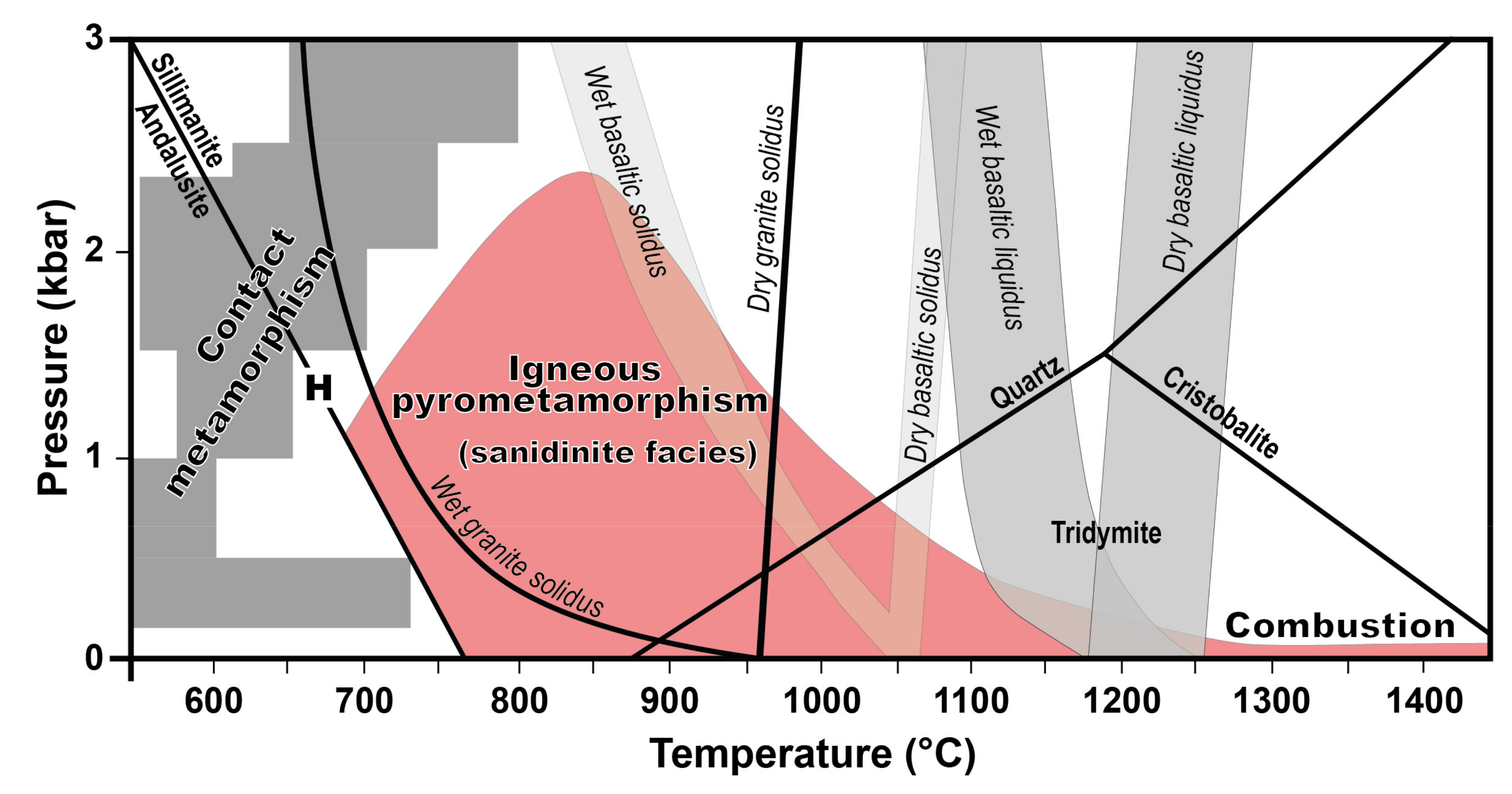
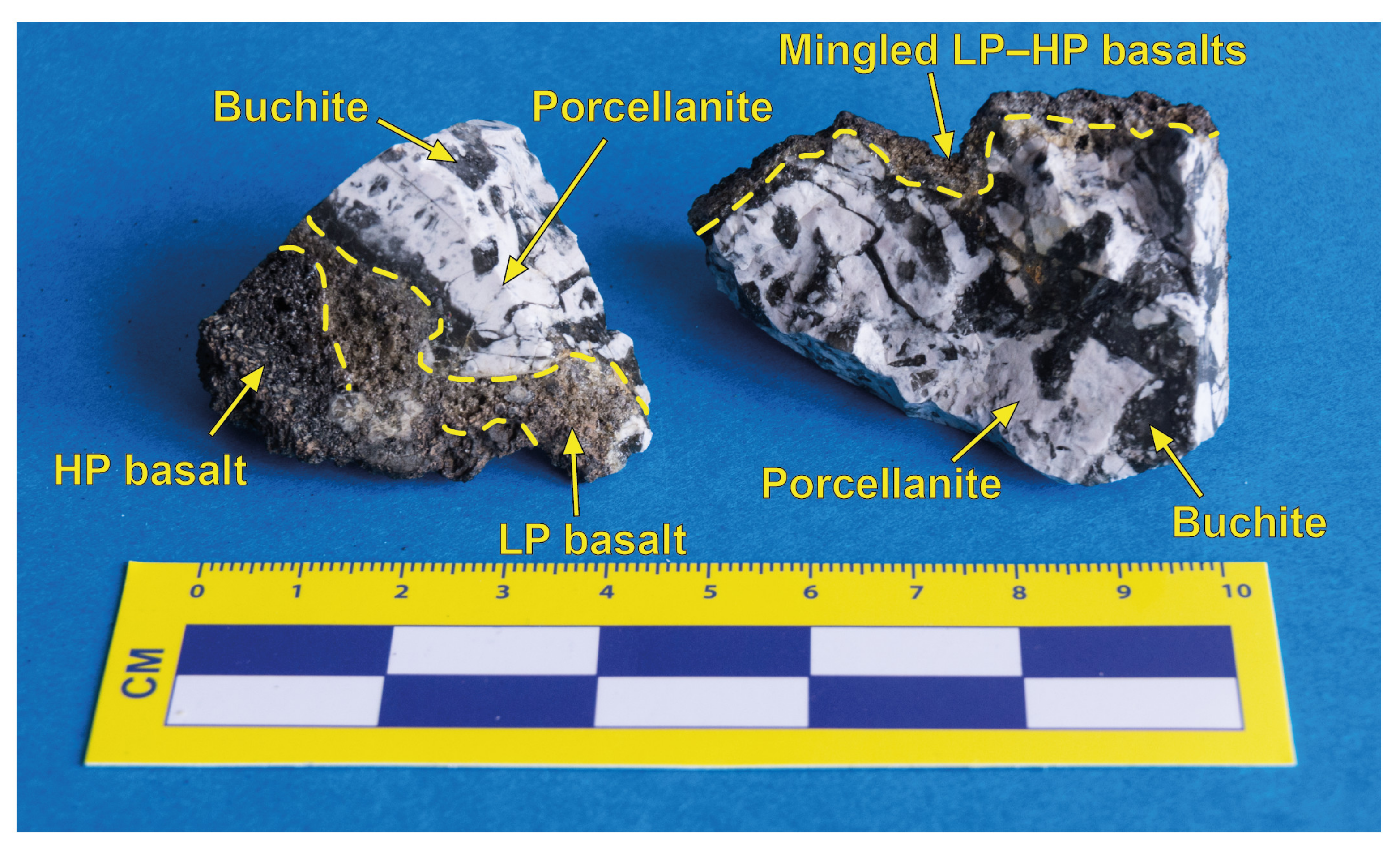
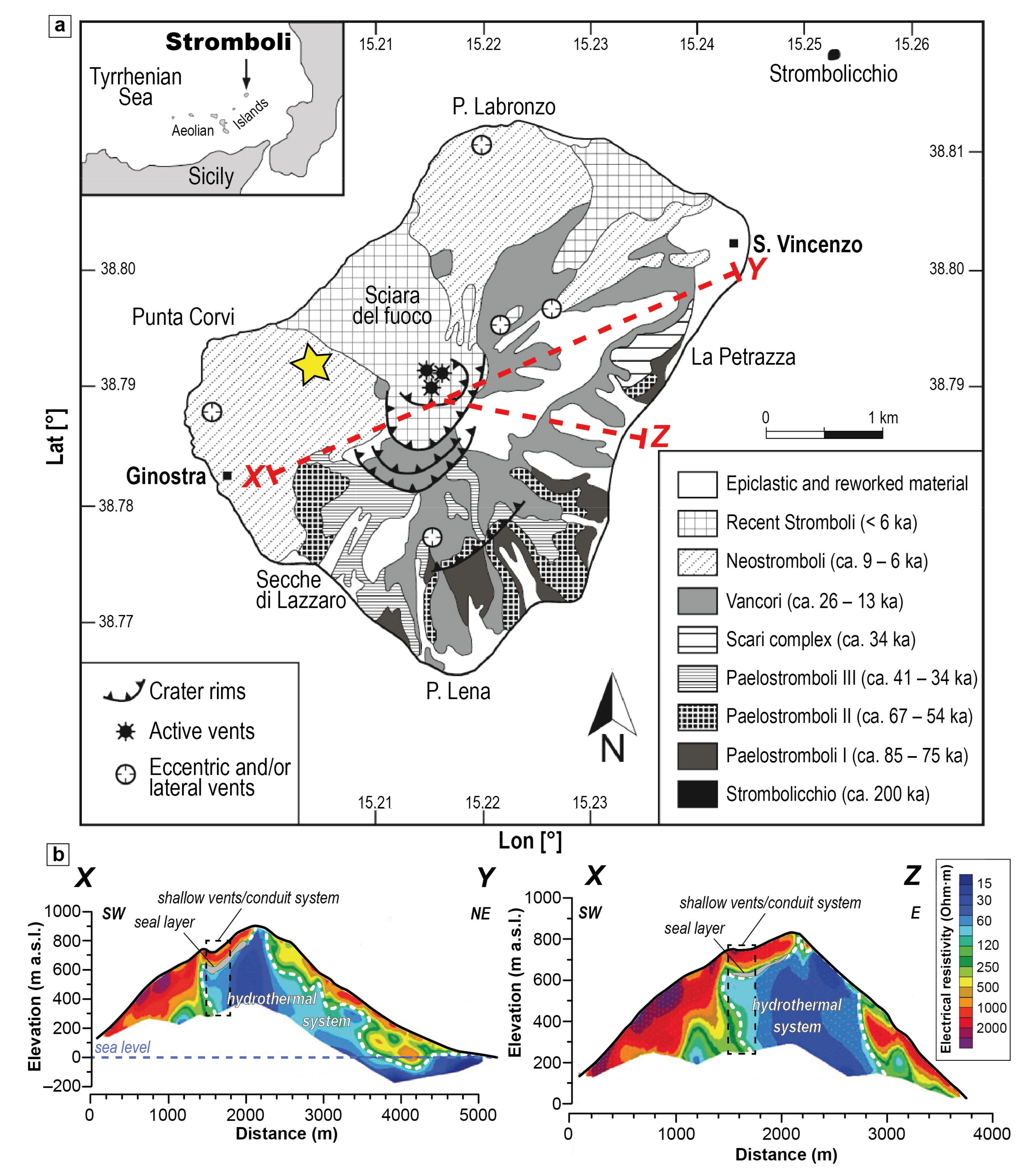

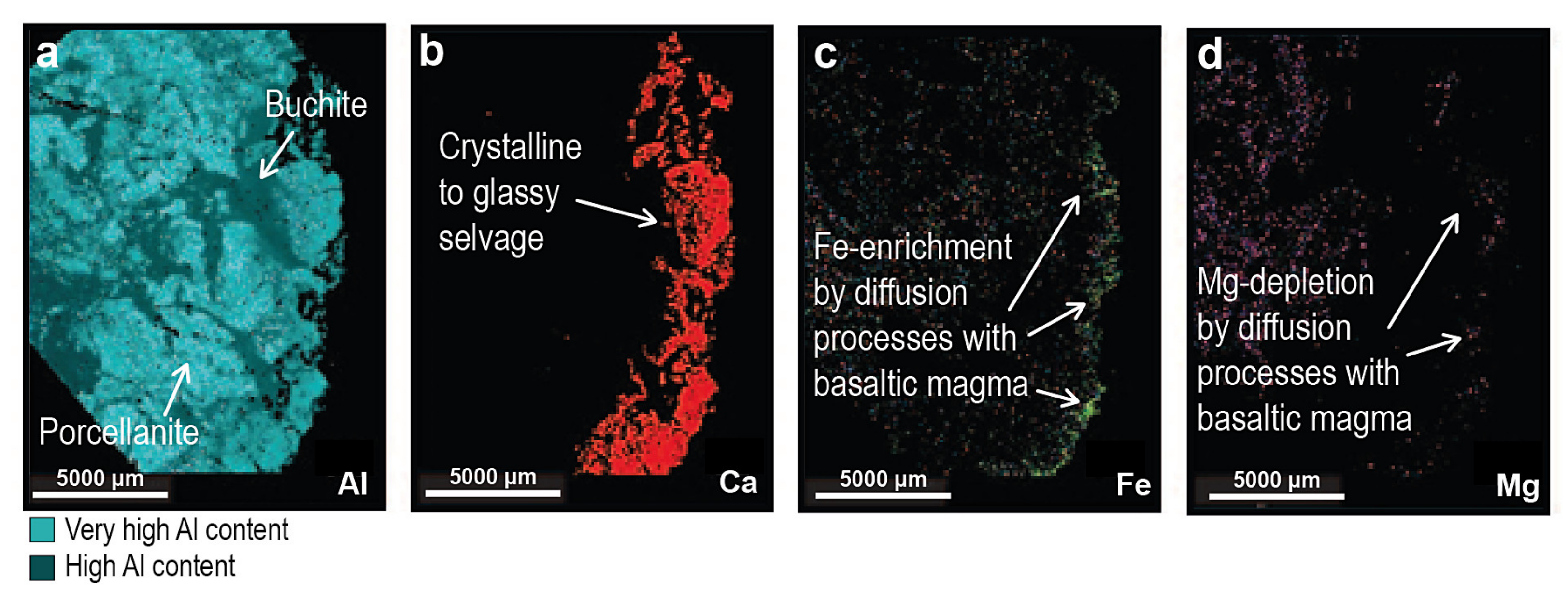
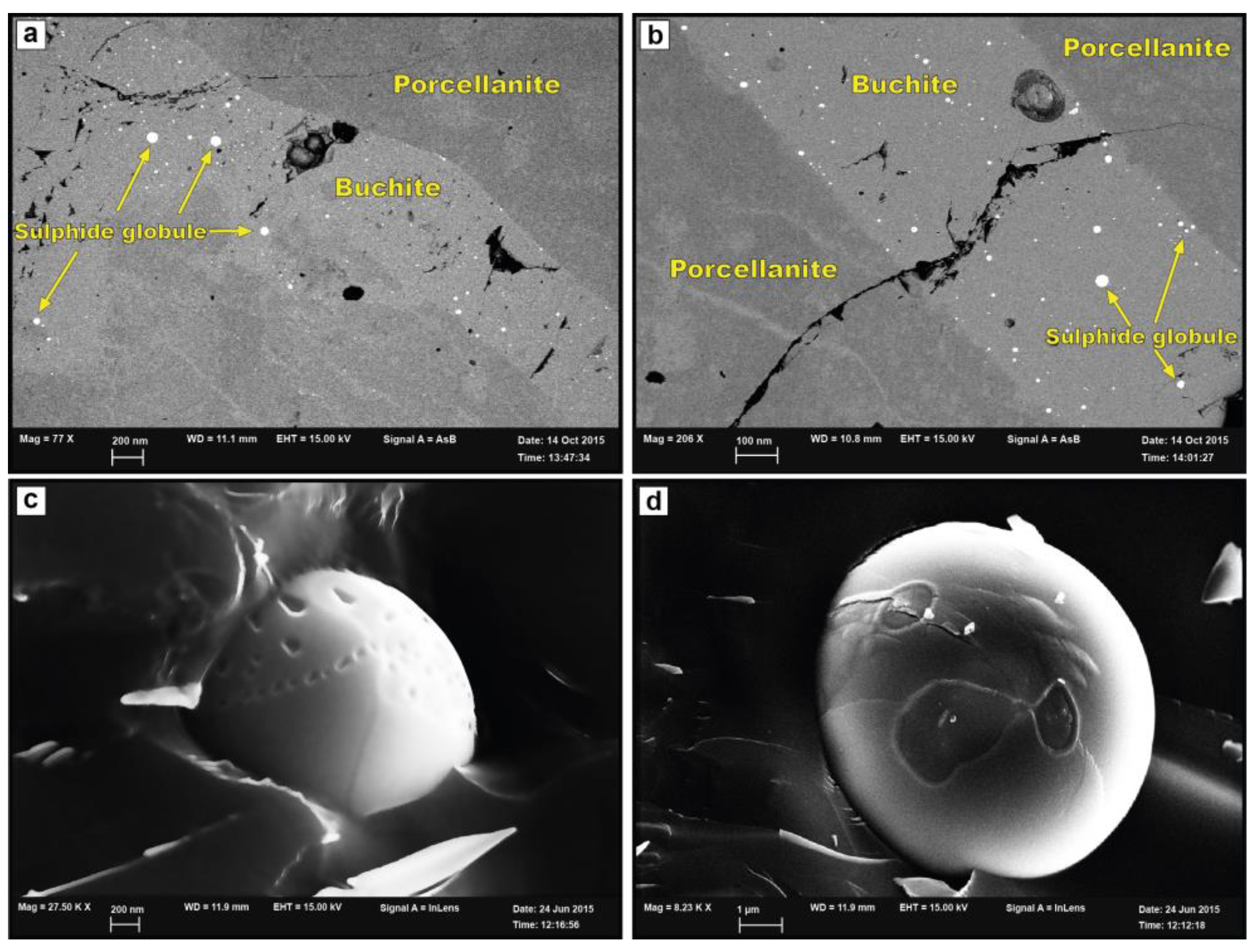
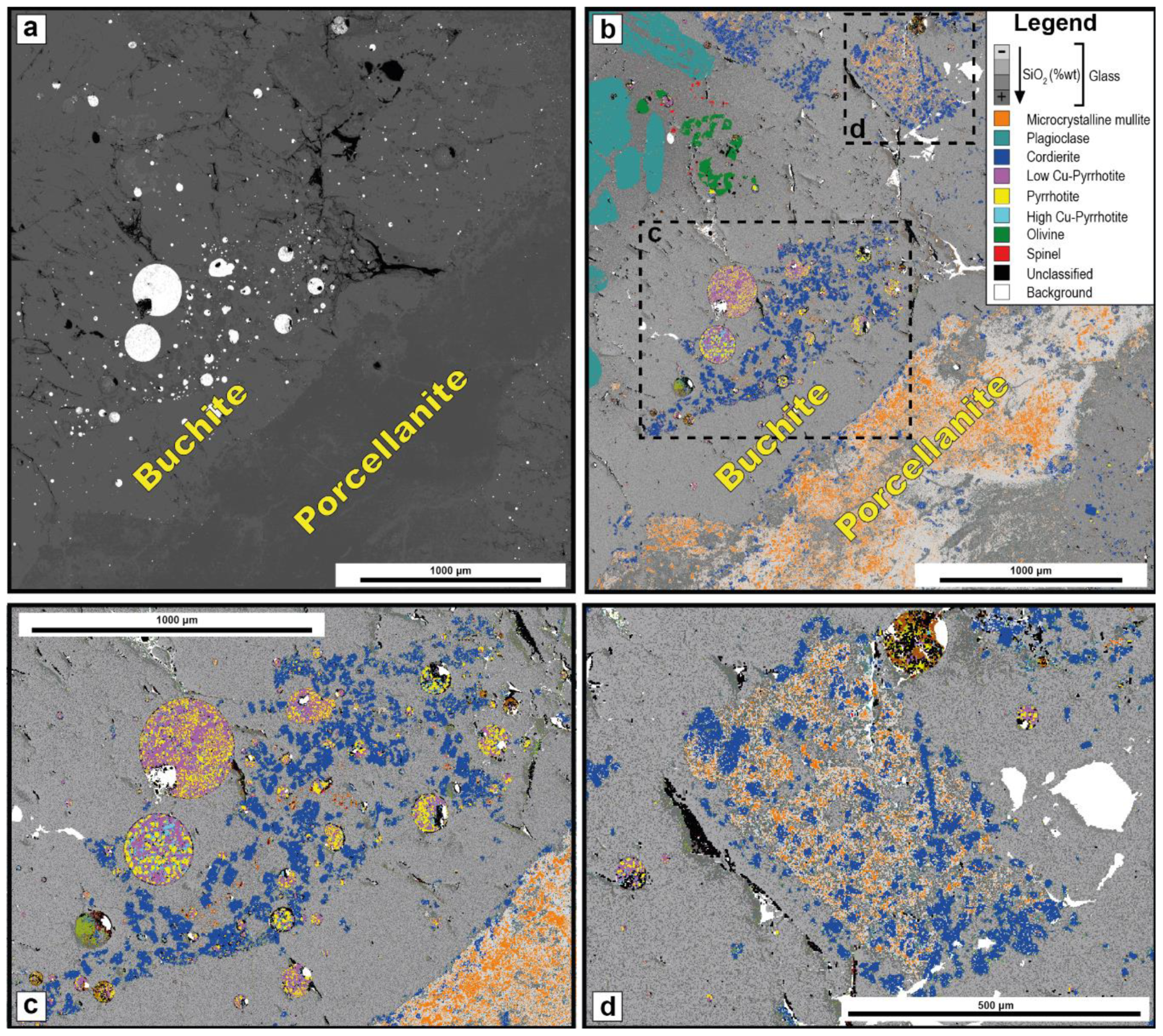


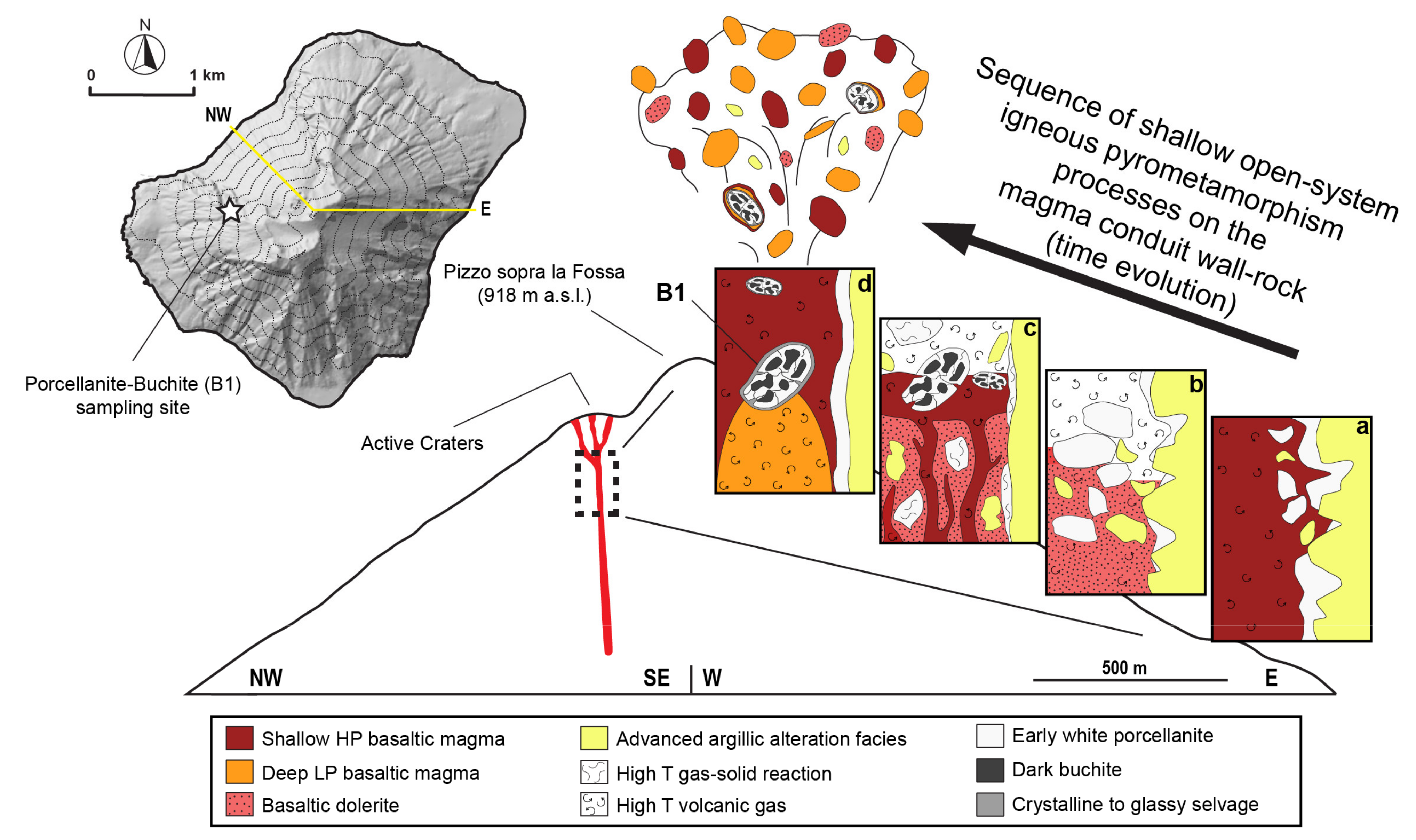
| Oxide | PG | PG | PG | PG | PG | PG | PG | BG | BG | BG | BG | BG | BG | BG | BG | PG* | HSG1* | HSG2* |
|---|---|---|---|---|---|---|---|---|---|---|---|---|---|---|---|---|---|---|
| SiO2 | 55.1 | 54.5 | 54.4 | 53.3 | 52.9 | 50.7 | 50.5 | 79.7 | 77.5 | 74.7 | 69.6 | 67.5 | 66.0 | 63.0 | 61.0 | 53.4 | 77.7 | 65.9 |
| TiO2 | 0.28 | 0.57 | 0.42 | 0.32 | 0.46 | 0.33 | 0.33 | 0.55 | 0.51 | 0.96 | 0.32 | 0.49 | 0.40 | 0.55 | 1.26 | 0.32 | 0.52 | 0.68 |
| Al2O3 | 37.3 | 37.3 | 38.0 | 39.0 | 39.3 | 42.2 | 42.3 | 11.1 | 13.0 | 14.2 | 17.0 | 17.3 | 20.8 | 19.0 | 20.1 | 39.0 | 13.0 | 18.7 |
| FeOtot | 0.92 | 1.02 | 0.85 | 0.88 | 1.03 | 0.85 | 0.94 | 0.64 | 1.04 | 0.97 | 1.75 | 1.46 | 2.20 | 2.78 | 2.07 | 0.87 | 1.04 | 1.26 |
| MgO | 0.23 | 0.34 | 0.56 | 0.33 | 0.49 | 0.27 | 0.32 | 0.20 | 0.24 | 0.33 | 0.41 | 0.64 | 3.27 | 1.78 | 1.22 | 0.33 | 0.23 | 0.70 |
| CaO | 0.49 | 0.49 | 0.43 | 0.59 | 0.52 | 0.53 | 0.57 | 0.37 | 0.60 | 0.74 | 0.92 | 0.69 | 0.69 | 1.46 | 1.42 | 0.59 | 0.60 | 0.91 |
| Na2O | 1.56 | 1.51 | 1.46 | 1.48 | 1.50 | 1.42 | 1.41 | 1.91 | 1.42 | 1.81 | 2.39 | 3.63 | 1.68 | 4.03 | 4.29 | 1.48 | 1.42 | 3.94 |
| K2O | 3.70 | 3.76 | 3.53 | 3.65 | 3.45 | 3.17 | 3.21 | 5.54 | 5.30 | 5.94 | 5.99 | 7.60 | 4.40 | 7.16 | 7.23 | 3.65 | 5.30 | 7.70 |
| P2O5 | 0.41 | 0.48 | 0.30 | 0.46 | 0.30 | 0.50 | 0.48 | - | 0.35 | 0.37 | 0.80 | 0.55 | 0.57 | 0.23 | 1.41 | - | - | - |
| SO3 | - | - | - | - | - | - | - | - | - | - | 0.84 | 0.18 | - | - | - | - | - | - |
| Total | 99.99 | 99.97 | 99.95 | 100.01 | 99.95 | 99.97 | 100.06 | 100.01 | 99.96 | 100.02 | 100.02 | 100.04 | 100.01 | 99.99 | 100 | 99.64 | 99.81 | 99.79 |
Publisher’s Note: MDPI stays neutral with regard to jurisdictional claims in published maps and institutional affiliations. |
© 2021 by the authors. Licensee MDPI, Basel, Switzerland. This article is an open access article distributed under the terms and conditions of the Creative Commons Attribution (CC BY) license (https://creativecommons.org/licenses/by/4.0/).
Share and Cite
Renzulli, A.; Taussi, M.; Brink, F.J.; Del Moro, S.; Henley, R.W. Sulphide Globules in a Porcellanite–Buchite Composite Xenolith from Stromboli Volcano (Aeolian Islands, Southern Italy): Products of Open-System Igneous Pyrometamorphism. Minerals 2021, 11, 639. https://doi.org/10.3390/min11060639
Renzulli A, Taussi M, Brink FJ, Del Moro S, Henley RW. Sulphide Globules in a Porcellanite–Buchite Composite Xenolith from Stromboli Volcano (Aeolian Islands, Southern Italy): Products of Open-System Igneous Pyrometamorphism. Minerals. 2021; 11(6):639. https://doi.org/10.3390/min11060639
Chicago/Turabian StyleRenzulli, Alberto, Marco Taussi, Frank J. Brink, Stefano Del Moro, and Richard W. Henley. 2021. "Sulphide Globules in a Porcellanite–Buchite Composite Xenolith from Stromboli Volcano (Aeolian Islands, Southern Italy): Products of Open-System Igneous Pyrometamorphism" Minerals 11, no. 6: 639. https://doi.org/10.3390/min11060639
APA StyleRenzulli, A., Taussi, M., Brink, F. J., Del Moro, S., & Henley, R. W. (2021). Sulphide Globules in a Porcellanite–Buchite Composite Xenolith from Stromboli Volcano (Aeolian Islands, Southern Italy): Products of Open-System Igneous Pyrometamorphism. Minerals, 11(6), 639. https://doi.org/10.3390/min11060639







